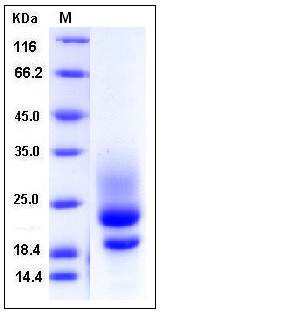Human CD83 / HB15 Protein (His Tag)
BL11,HB15
- 100ug (NPP3716) Please inquiry
| Catalog Number | P11763-H08H |
|---|---|
| Organism Species | Human |
| Host | Human Cells |
| Synonyms | BL11,HB15 |
| Molecular Weight | The recombinant human CD83 consists of 135 amino acids and predictes a molecular mass of 15.5 kDa. In SDS-PAGE under reducing conditions, the apparent molecular mass of rh CD83 is approximately 20-30 kDa due to different glycosylation. |
| predicted N | Thr 20 |
| SDS-PAGE |  |
| Purity | > 92 % as determined by SDS-PAGE |
| Protein Construction | A DNA sequence encoding the human CD83 (Q01151-1) extracellular domain (Met 1-Ala 143) was expressed, with a polyhistidine tag at the C-terminus. |
| Bio-activity | |
| Research Area | Immunology |Cluster of Differentiation (CD) |T Cell CD Antigen |
| Formulation | Lyophilized from sterile PBS, pH 7.4 1. Normally 5 % - 8 % trehalose and mannitol are added as protectants before lyophilization. Specific concentrations are included in the hardcopy of COA. |
| Background | The cluster of differentiation (CD) system is commonly used as cell markers in immunophynotyping. Different kinds of cells in the immune system can be identified through the surface CD molecules which associating with the immune function of the cell. There are more than 320 CD unique clusters and subclusters have been identified. Some of the CD molecules serve as receptors or ligands important to the cell through initiating a signal cascade which then alter the behavior of the cell. Some CD proteins do not take part in cell signal process but have other functions such as cell adhesion. CD83 is considered as a marker of mature dendritic cells as well as an adhesion receptor that binds to resting monocytes and a subset of activated CD8+ T cells. In certain conditions, CD83 tended to dimerize or even multimerize through its aberrant intermolecular disulfide bonds. The injection of CD83-Ig can significantly enhaunce the rate of tumor growth and inhibit the T cell growth. |
| Reference |
